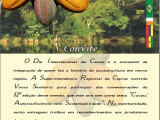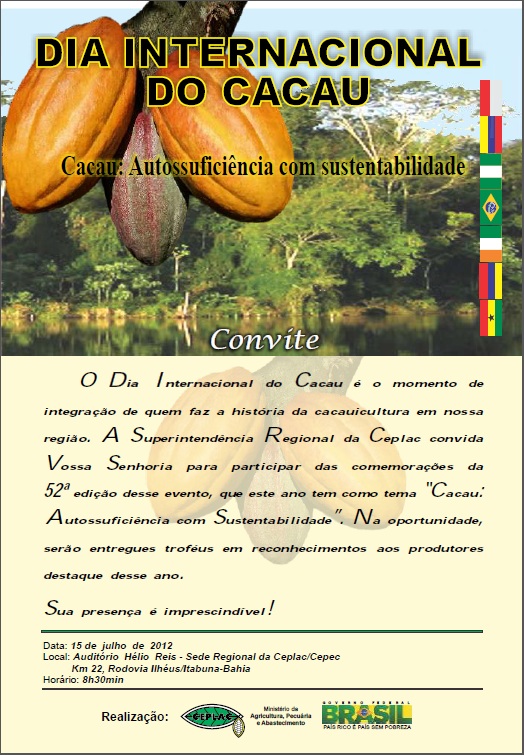Este post também está disponível em:
Português
English

According to historians, the cacao tree, called cacahualt, was considered sacred.
In Mexico, the Aztecs believed it to be of divine origin and that the prophet Quatzalcault himself had taught the people how to cultivate it both for food and to embellish the gardens of the city of Talzitapec. Its cultivation was accompanied by solemn religious ceremonies.
This religious significance probably influenced the Swedish botanist Carolus Linneu (1707 – 1778), who named the plant Theobroma cacao, thus calling it the “delicacy of the gods”.
The Indians considered cocoa beans so valuable that they used them as currency. Four hundred beans were worth a countle and 8,000 a xiquipil.
Emperor Montezuma used to receive 200 xiquipils (1.6 million seeds) annually as tribute from the city of Tabasco, which would correspond today to approximately 30 bags of 60 kilos.
It is said that even a good slave could be exchanged for 100 seeds. Still on the use of cocoa as currency, Peter Martyr of Algeria wrote in 1530, in the book DE ORBE NOVO PETRI MARTYRES AB ALGERIA: “Blessed money, which provides a sweet drink and is a benefit to mankind, protecting its possessors against the infernal plague of greed, for it cannot be hoarded long or hidden underground.”
Video chocolate factory of CEPLAC BA

Fabrica de Chocolate
1. The cocoa tree is the tree of golden fruits
The cocoa tree originated in rain forest regions of Tropical America, where it is still found in the wild from Peru to Mexico. It is classified in the genus Thebroma, family of Sterculiaceae.
It was first mentioned in botanical literature by Charles de l’ Ecluse, who described it under the name Cacao fructus. In 1937, it was described as Theobroma fructus by Linneu, who in 1753 proposed the name Theobroma cacao, which remains today.
Botanists believe that cacao originated in the headwaters of the Amazon River, having spread in two main directions, giving rise to two important groups: Criollo and Forastero.
The Criollo, which spread northwards to the Orinoco River, penetrating Central America and southern Mexico, produces large fruits with a wrinkled surface. Its seeds are large, with a white or pale violet interior. It was the type of cocoa cultivated by the Aztec and Mayan Indians.
The Forastero spread down the Amazon basin and towards the Guianas. It is considered the true Brazilian cocoa and is characterised by ovoid fruits, with a smooth surface, imperceptibly furrowed or wrinkled. The inside of its seeds is dark violet or sometimes almost black.
To develop better, the cocoa tree requires deep and rich soils and a warm and humid climate, with an average temperature of about 25°C and annual rainfall between 1,500 and 2,000 millimetres, without prolonged dry periods.
2. The Long Journey of Cocoa
As cocoa gained economic importance with the expansion of chocolate consumption, several attempts were made to establish cocoa plantations in other regions with climate and soil conditions similar to those of its natural habitat.
As a result, its seeds gradually spread throughout the world. By the middle of the 18th century, cocoa had reached the south of Bahia and, in the second half of the 19th century, it was taken to Africa.
The first African plantations were made around 1855 on the islands of São Tomé and Príncipe, Portuguese colonies off the west coast of Africa.
Officially, cocoa cultivation began in Brazil in 1679, through the Royal Charter that authorised the colonisers to plant it on their lands.
Several attempts made in Pará to realise this directive failed mainly because of the poverty of the soils of that region. Nevertheless, by 1780, Pará was producing more than 100 arrobas of cocoa.
Cultivation, however, was not established at that time and remained a simple extractive activity until recent years.
3. Cocoa is a wealth generating foreign exchange
In 1746 Antonio Dias Ribeiro, from Bahia, received some seeds of the Amelonado group – Forastero- from a French coloniser, Luiz Frederico Warneau, from Pará, and introduced the crop in Bahia.
The first planting in this state was made in the Cubículo farm, on the banks of the Pardo River, in the current municipality of Canavieiras. In 1752 plantations were made in the Municipality of Ilhéus.
Cocoa adapted well to the climate and soil of Southern Bahia, a region that today produces 95% of Brazilian cocoa, with Espírito Santo with 3.5% and the Amazon at 1.5%.
Brazil is the 5th largest cocoa producer in the world, alongside Ivory Coast, Ghana, Nigeria and Cameroon. In 1979/80, Brazilian cocoa production exceeded 310,000 tonnes.
About 90% of all Brazilian cocoa is exported, generating foreign exchange for the country. In the period 1975/1980, cocoa generated 3 billion 618 million dollars.
4. Cocoa AND CHOCOLATE
The civilised world only became aware of the existence of cocoa and chocolate after Christopher Columbus discovered America.
Until then, they were the privilege of Indians living in southern Mexico, Central America and the Amazon basin, where cocoa grew naturally in the middle of the forest.
Today, almost 5 centuries later, cocoa derivatives are consumed in many forms, in almost all countries, and are part of the life of modern man.
They are present everywhere: in soldiers’ rucksacks and students’ bags, in chocolate bars of high nutritional value; in the most sophisticated beauty salons, in the most varied forms of cosmetics; and at social gatherings, through wines and liqueurs. Its residues are used as fertiliser and animal feed.
Leaving the Amazon rainforest to conquer the world, cocoa has travelled a long way. Its history, surrounded by legend, is marked by curious episodes: it was used by the Aztecs as currency, it provoked discussion among religious about its use in convents due to its supposed aphrodisiac properties and, for a long time, it was an exclusive drink of the most luxurious courts of Europe.
Its seeds, taken to other regions and continents, formed large plantations that, today, represent an important source of work and income for millions of people.
4.1. Energy Value of Chocolate
Chocolate is the best balanced food there is, containing a well-balanced association of cocoa, milk and sugar.<nbsp; Due to its high carbohydrate and fat content, chocolate has quite appreciable protein rates.
A 100-gram tablet corresponds to 6 eggs or 3 glasses of milk or 220 grams of white bread or 750 grams of fish or 450 grams of beef.
4.2. MULTIPLE USES OF COCOA
- Beyond Chocolate
Cocoa is reminiscent of chocolate. It has always been so, since the Aztecs, who included Chocolate in their religious ceremonies. Now, cocoa juice is also being industrialised from the fruit of the cocoa tree by extracting its pulp.
Cocoa pulp can also be used to make jellies, fine spirits, fermented products – such as wine and vinegar – and syrups for confectionery, as well as nectars, ice cream, sweets and yoghurt. There is a large and immediate market, especially for cocoa juice, both at home and abroad.
- Research Makes a Profit
Research developed by MA/CEPLAC has recently begun to generate technologies capable of optimising cocoa production through the full use of by-products and post-harvest residues.
This programme, in addition to contributing to diversifying the income of rural properties, can result in a significant increase in the net income of the cocoa producer, making him less dependent on the fluctuations of the external market, which regulates the price of the product.
- Cocoa seed is worth gold
The cocoa tree has always been cultivated to utilise only the seeds of its fruits, which are the raw material for the chocolate industry. The dried seeds account for a maximum of 10 per cent of the weight of the cocoa fruit.
It is only recently that the remaining 90% has begun to arouse the interest of producers, based on studies carried out by MA/CEPLAC technicians. One tonne of dried cocoa, for example, represents 400 to 425 kg of whole pulp.
- The cocoa husk also has a use
The husk of the cocoa tree fruit can also be used economically, as attested by research by MA/CEPLAC technicians.
It is used to feed cattle, both in natura and in the form of dry shell flour or silage, as well as for pigs, poultry and even fish.
The cocoa bean husk can also be used in the production of biogas and biofertiliser, in the composting or vermicomposting process, to obtain microbial or unicellular protein, in the production of alcohol and in the extraction of pectin. One tonne of dried cocoa produces 8 tonnes of fresh husk.
- An exotic flavour of cocoa
Cocoa juice has a very characteristic flavour, considered exotic and very pleasant to the palate, resembling the juice of other tropical fruits such as bacuri, cupuaçu, graviola, acerola and taperebá.
It is fibrous and rich in sugars (glucose, fructose and sucrose) and also in pectin. In terms of protein and some vitamins, it is equivalent to acerola, guava and umbu juices. Some of the substances that make up cocoa juice give it a high viscosity and pasty appearance.
- Hand in hand
Stimulating the production of cocoa juice and opening up markets for producers by pooling efforts and diluting costs.
These are, in summary, the actions that cocoa producers aim at with the creation of their Association of Pulp and Fruit Producers of the Rio das Contas Valley.
MA/CEPLAC supports this initiative and even co-sponsored a workshop in the cocoa region of Bahia entitled “The resumption of the Agroindustrial Pole of the Rio de Contas Valley”.
Aprosuco has its headquarters (in installation) in the cocoa region itself, in the city of Ipiaú. Contacts can be made through the telephone (0XX) 73 – 3531-3856.
Cocoa by-products with reference to an annual productivity of 750 kg of dry product per hectare:
By-products Yields
Dried cocoa ……. 750 Kg
Fresh seed 1.875 Kg
Cocoa honey …. 200 litres
Jelly …………. 150 Kg
Vinegar ……….. 180 litres
Distilled ……. 25 25 litres
Pulp ………… 300 to 400 litres
Frozen juice ..300 to 400 litres
Nectar …………600 to 800 litres
Jellied ……..200 to 300 litres
Bahia.ws is the largest tourism and travel guide for Bahia and Salvador.



















